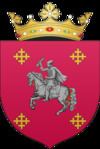Time zone EET (UTC+2) Area code(s) +373 44 Area 753 km² Local time Wednesday 1:57 AM | Postal Code 244 Car plates CL Population 78,800 (2012) | |
 | ||
Weather 7°C, Wind E at 10 km/h, 85% Humidity | ||
Călărași is a district (Moldovan: raion) in the central part of Moldova, with the administrative center at Călărași. This region is very popular for its red wine, white wine, cognac. While Republic of Moldova were a part of Soviet Union, its wine were known far in all USSR. As of January 1, 2011, its population was 78,800.
Contents
- Map of CC483lC483raC899i District Moldova
- History
- Geography
- Climate
- Fauna
- Flora
- Plaiul Fagului
- Rivers
- Administrative subdivisions
- Demographics
- Religion
- Economy
- Education
- Politics
- Culture
- Health
- Tourism
- Personalities
- References
Map of C%C4%83l%C4%83ra%C8%99i District, Moldova
History
The district territory is inhabited since Paleolithic, 50-40.000 years ago. Settlements with the earliest documentary attestation of the district are: Horodiște, Pitușca, and Sadova, they are certified in 1420. During the component was in the Principality of Moldova (1359-1812), the current Călărași territory held by the Orhei - Lăpuşna County. After dividing the land Orhei - Lapusna in two separate counties, some localities have passed Orhei County and the other part Lăpușna County. From the 16th through the 18th centuries, the district developed economically (trade, wine), culturally (to build monasteries, Frumoasa, Hârbovăţ and Răciula) and grew in population. After the Treaty of Bucharest, Basarabia is occupied by the Russian Empire at this time there is an intense russification of the native population. In 1918 after the collapse of the Russian Empire, Basarabia united with the motherland Romania but for a short time (1918–1940, 1941–1944). In 1940 after the Molotov-Ribbentrop Treaty, the territory between the Prut and Nistru is busy again this time the USSR. In 1991 as a result of the proclamation of Independence of Moldova, part of the Ungheni County (1991–2003), and in 2003 became administrative unit of Moldova.
Geography
Calarasi District is located in central part of Moldova. It borders with Teleneşti District in the north, east Orhei District, Străşeni District in south, south-west Nisporeni District and Ungheni District in west. Very rugged terrain, crossed the slopes with different degrees of tilt conditioning Central Moldavian Plateau, and is located in Codri. Chernozem soil in valleys, and brown soil on the plateau. Maximum altitude in the district is 400 meters, the rate reached in the south-western part of district.
Climate
The climate is temperate-continental. The average air temperature is +9 °C. Average January temperature -5 °C (-25-27 °C minimum) and in July +21+21.5 °C (maximum +36 °C). Yearly precipitation] 550–650 mm. Average wind speed 4–6 m s.
Fauna
Fauna characteristic of the so animals such as: fox, wild cat, marten, rabbit, squirrel, deer, wild boar, wolf, red deer and others and the world of birds may be mentioned: blackbird, pigeon, jay, finch, eagle, woodpecker and other.
Flora
Forests occupy 30.7% of district territory, dominate species: hornbeam, beech, ash, elm, oak, white, lime, etc. In strips of forest are encountered: horn, hawthorn, bat, maples and other.
Plaiul Fagului
State Nature Reserve "Plaiul Fagului" was created on March 12, 1992 for the conservation, regeneration, environmental recovery, study one of the most picturesque and representative forest ecosystems in the Codri. The total area of reserve is 5642 ha, of which forests occupy 4639 ha (82.2%). The territorial-administrative structure includes 5387 hectares of natural tree, beech formations including 272 ha (4.8%), ash 1163 ha (20.6%), sessile oak 1039 ha (18.4%), lime 170 ha (3.1%) other species, 169 ha (3.0%). Flora includes 909 species, including 645 species of vascular plants, 151 species of fungi, 48 species of lichens, 65 species of moss. Fauna: As mentioned Dimitrie Cantemir, in this land dwelling deer, bears, reindeer, martens, wolves, wild boar. Arable land expansion has contributed significantly to the reduction of forested area, the numerical reduction plants and animals. Uncontrolled hunting disappearance of conditioned bear, deer, lynx, wolf, black grouse etc.
Rivers
District is located in the Nistru river basin, a tributary that crosses the district are: Bic, Ichel and Cula. Most lakes are of natural origin, but are rich in fish.
Administrative subdivisions
Demographics
1 January 2012 the district population was 78,800 of which 20.7% urban and 79.3% rural population
Religion
Economy
The district recorded a total of 21,200 enterprises, of which individual enterprises 673 units, 19,792 units farms, enterprises with the legal person status 800. SMEs constitute about 99% of all enterprises. Here is a winery and a cognac factory is one of the first in Moldova and other enterprises in the food industry (canned food, sugar, dairy products). Food industry (dairy) there is a factory that produces dairy products quality first. Agricultural land - 25 801 ha (34.1%), including arable land - 13,323 ha (16.7%), orchards - 3138 ha (4.1%), vine - 6020 ha (8.0%), pastures - 7384 ha (9.8%) other - 394.7 ha (0.5%). Main crops: cereals (wheat, oats), corn, sunflower, rapeseed and soy.
Education
In Calarasi district works: 31 kindergartens, 34 schools, a multipurpose school, college and a special auxiliary school. Total number of students: in schools - 8176 students, in professional schools versatile - 269 students, college teaching "Alexandru cel Bun" 553 students.
Politics
Calarasi district in terms of political support center-right parties. AEI enjoys a major support. PCRM here usually get poor results, the last three elections is a constant fall.
During the last three elections AEI had an increase of 68.9%
Culture
The district works: 37 houses and cultural centers, 42 libraries, 7 museums, three art schools. In total the district works, 103 artistic groups, including 23 as "model".
Health
The district operates: Călăraşi district hospital with 200 beds general fund, a Center of Family Physicians, 4 health centers, 27 family doctor's offices, three offices Health, 35 pharmaceutical subsidiaries.
